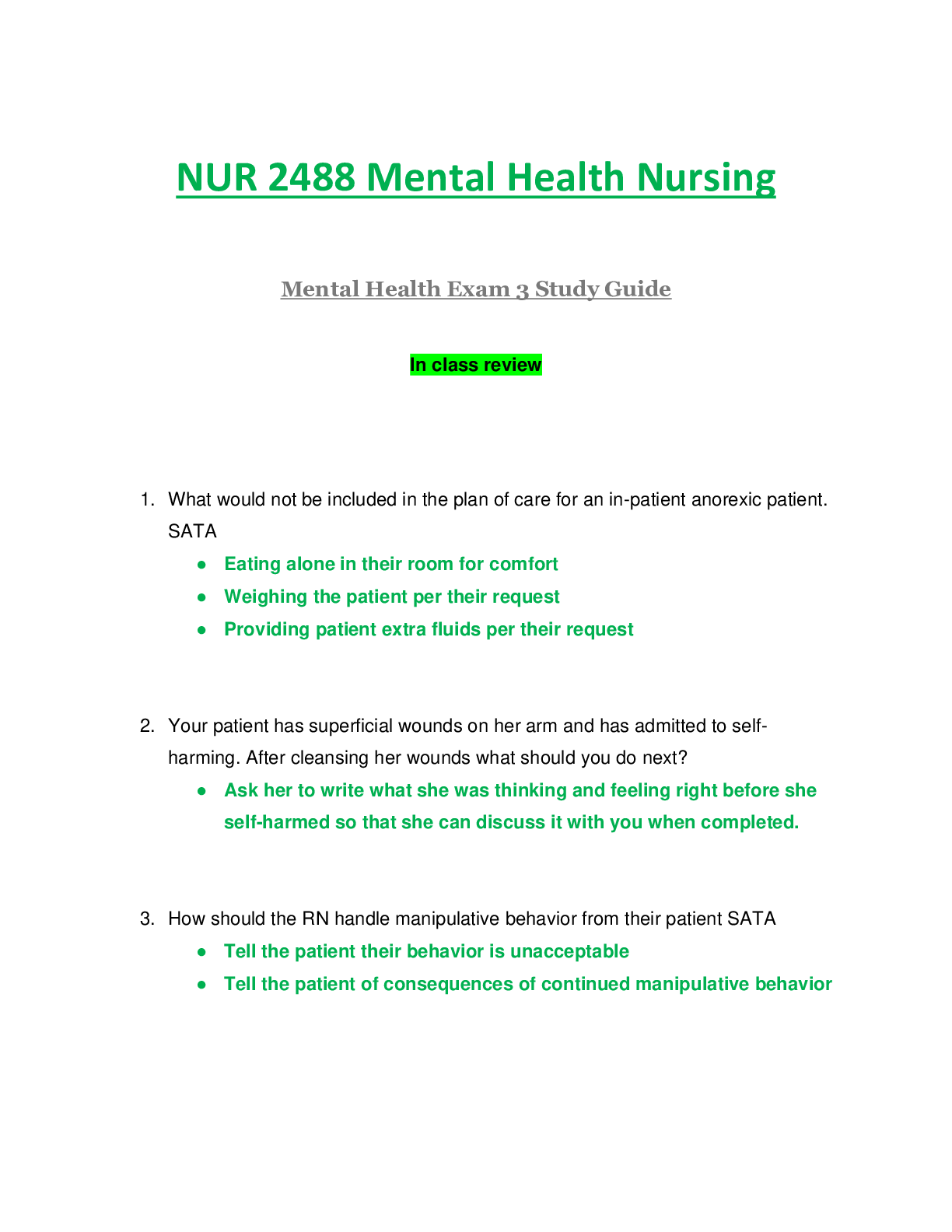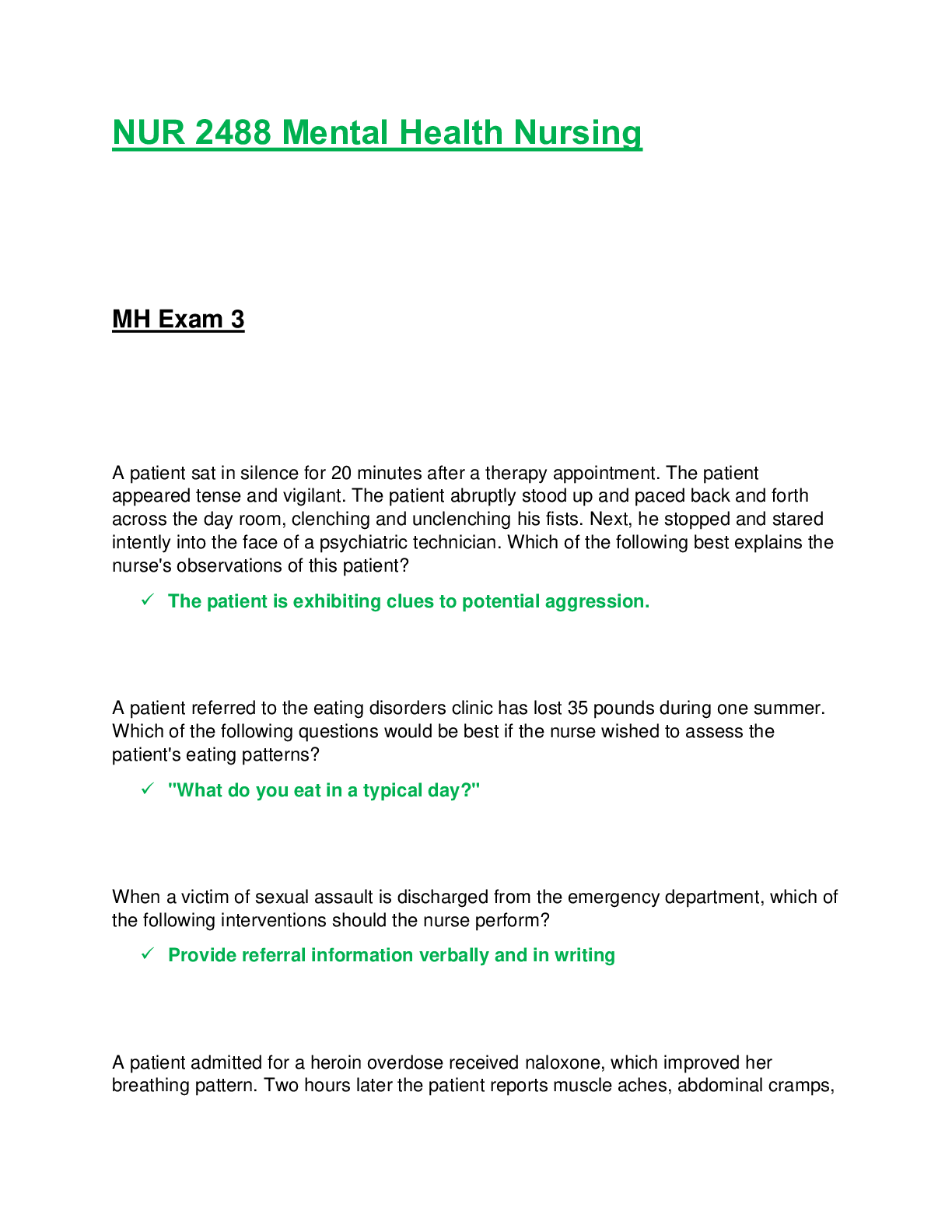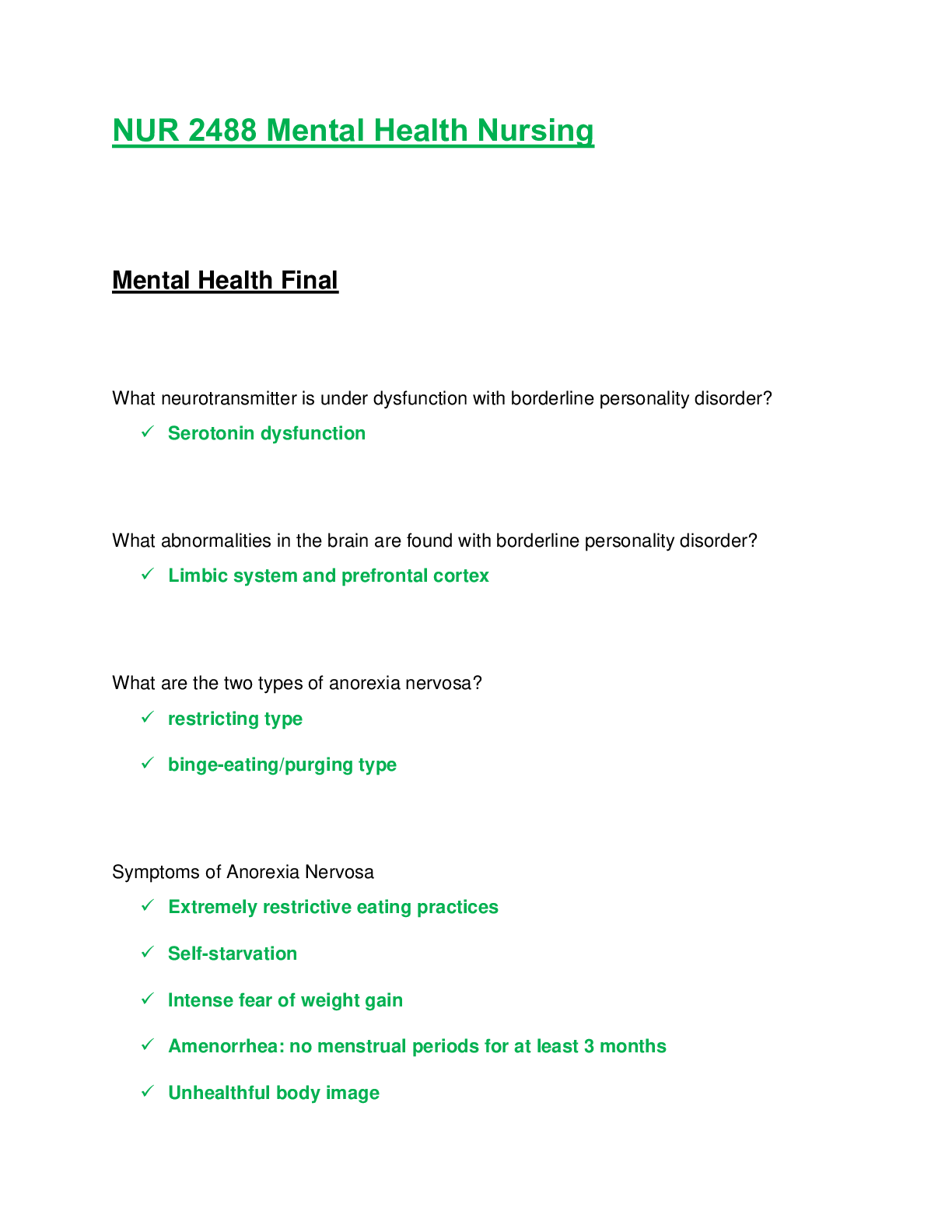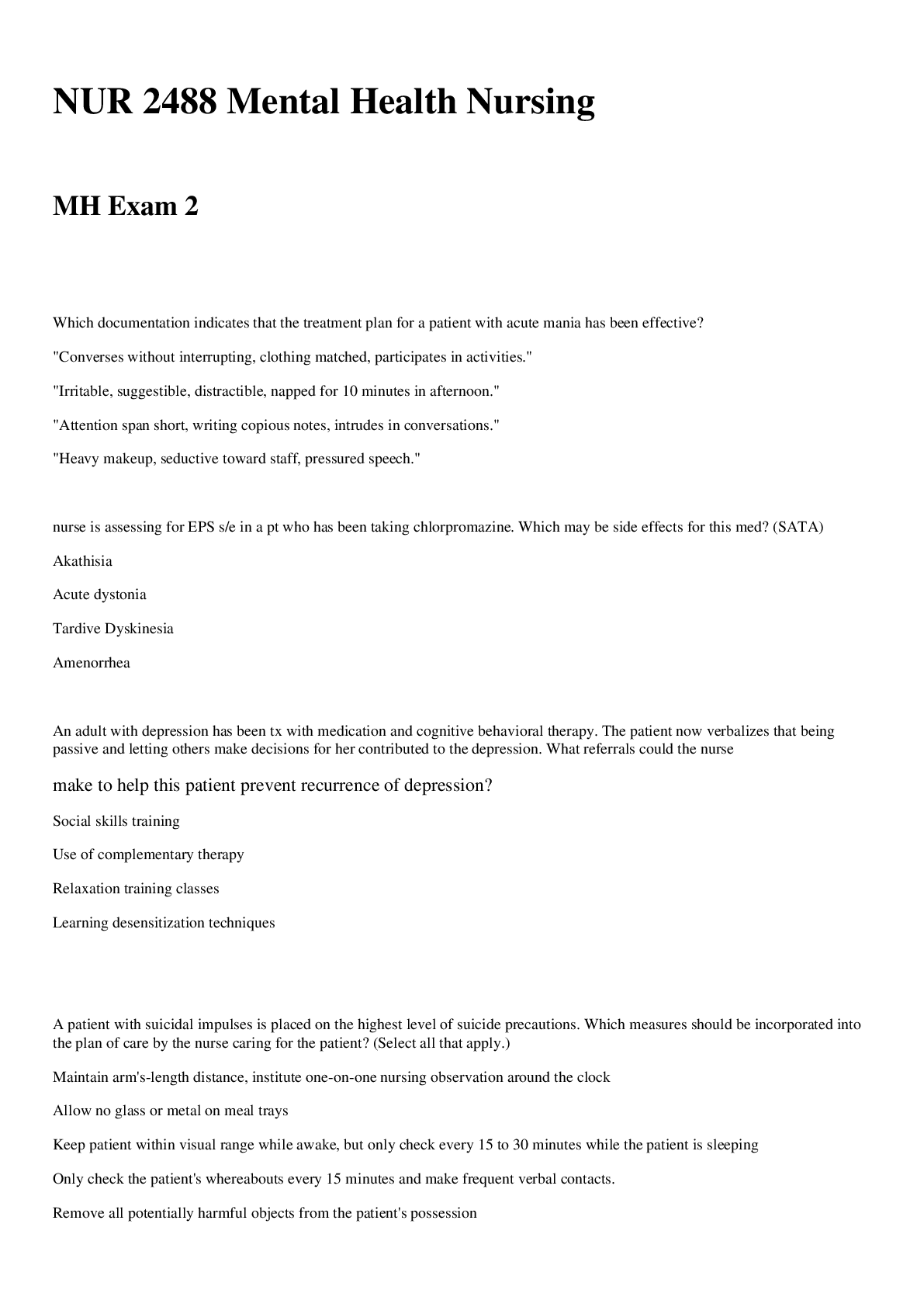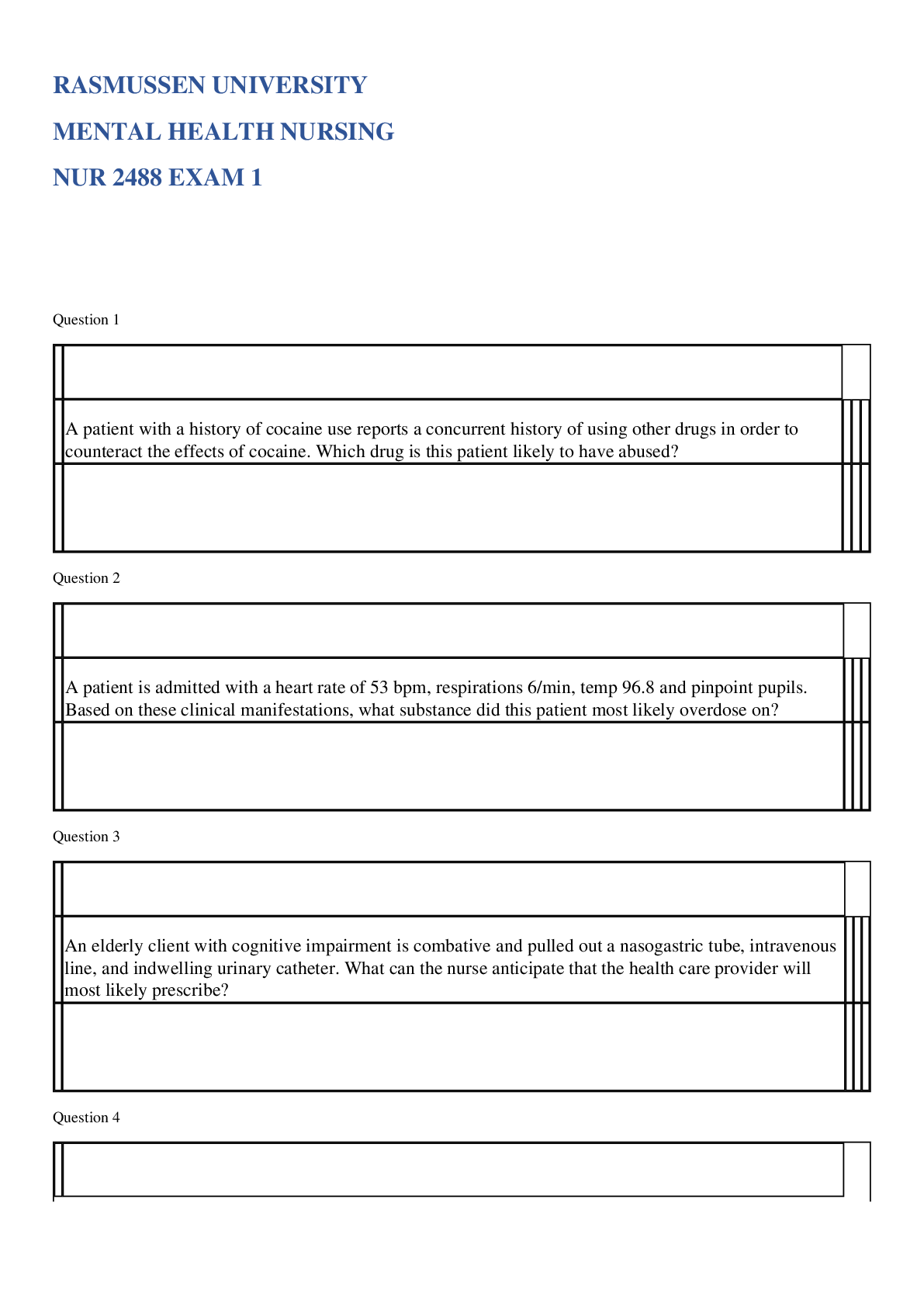PSYCHIATRIC AND MENTAL HEALTH NURSING HESI FINAL EXAM
Document Content and Description Below
1. Which of the following statements best describes a mentally healthy individual? A. Has ability to make decisions B. Does not exhibit physical and emotional problems C. Has self-acceptance and ca... n meet his own basic needs D. Has absence of anxiety and happy 2. The most important role of the Psychiatric nurse as a member of the team is to: A. carry out medical orders B. meet the needs for the physical well-being of the client C. coordinate the psychological care and management of clients D. keep a constant monitoring of the clients 3. Therapeutic use of self is essential in relating with psychiatric clients. This is BEST demonstrated in: A. sympathizing with the miserable feelings of the patient B. engaging patient in productive activity C. engaging patient in introspective thinking D. suppressing her own feelings toward the patient 4. The superego is the part of the psyche which: A. has sense of punishment B. contains primitive and instinctual drives C. makes use of defense mechanism D. forms adequate solutions to a problem 5. Suppression is best defined as: A. voluntary exclusion from consciousness unpleasant feelings, experiences, and thoughts B. involuntary exclusion from consciousness unpleasant feelings, experiences and thoughts C. channeling unacceptable desires into a socially acceptable behavior D. excessive reasoning or logic to avoid disturbed feelings 6. The unconscious defense mechanism that keeps highly anxious experiences out of conscious awareness is: A. Introjection B. Displacement C. Regression D. Repression 7. A defense mechanism wherein the individual dispels an action is: A. Fantasy B. Undoing C. Symbolism D. Substitution 8. A male college student who wants to become an athlete but fails becomes a well known writer. This is an example of: A. Compensation B. Projection C. Reaction Formation D. Sublimation 9. A third year student does a postmortem care without being disturbed by thought of death. He is using: A. Isolation B. Undoing C. Introjection D. Projection 10. A Biological/Medical approach to patient care utilizes which of the following? A. Milieu Therapy B. Somatic Therapy C. Behavioral Therapy D. Psychotherapy 11. The psychiatric nurse’s role in primary prevention includes the following EXCEPT: A. Providing sex education classes for adolescents B. Educating the public about mental health C. Handling crisis intervention in an outpatient setting D. Stress education and psychosocial support 12. Which of these nursing actions belong to the secondary level of prevention? A. Providing mental health consultation to health care providers B. Providing emergency psychiatric services C. Being politically active in relation to mental illness issues D. Providing mental health education to members of the community 13. The community health nurse was invited by a Principal of an Elementary school and was asked to give a talk to parents. An appropriate topic would be: A. the legal aspects of drug abuse B. disciplining children at home and school C. marital crisis D. problems of out of school youth 14. Trust may develop in the nurse-client relationship when the nurse: A. Avoids limit setting B. Encourages the client to use “testing” behaviors C. Tells the client how he should behave D. Uses consistency in approaching the client 15. In a therapeutic nurse-patient relationship, information about the termination phase is introduced: A. During the orientation phase B. During the working phase C. When the patient can tolerate it D. As the goals of the relationship are reached 16. Which of the following tasks should occur during working phase of the nurse-patient relationship? A. establishes trust and open communication B. assess the patient’s needs and develops plan of care C. promotes development of insight and self-concept D. establishes reality of separation and loss 17. Mrs. Reyes remarked, “I am worried about people visiting- with all the media news about child kidnapping and robberies.” The nurse BEST response would be: A. “Would you rather wish that I don’t come and visit you? You regard me as a stranger?” B. “I get that.” The nurse diverts the attention to talk about non-threatening topics C. “It must be distressing to think and feel the way that you do.” D. “I acknowledge what you are saying. My concern is the health care of your family and information are strictly confidential.” 18. Mrs. Reyes expressed that her socializing with neighbors is limited because her husband thinks she is getting overly friendly with a guy next door. Which of the following would the nurse emphasize as basic? A. Keeping trust in the relationship B. Avoid relating with neighbors to minimize conflict C. Be assertive to express her individuality D. Ignore the husband and just be supportive 19. A client has just begun to discuss important feelings when the time of the interview is up. The next day, when the nurse meets with the client at the agreed upon time, the initial intervention would be to say: A. “Good morning, how are you today?” B. “Yesterday you were talking about some very important feelings. Let’s continue.” C. “What would you like to talk about today?” D. Nothing and wait for the client to introduce a topic. 20. A new staff nurse is on orientation tour with the head nurse. A client approaches her and says, “I don’t belong here. Please try to get me out.” The staff nurse’s best response would be: A. “What would you do if you were out of the hospital?” B. “I am new staff member, and I’m on tour. I’ll come back and talk with you later.” C. “I think you should talk with the head nurse about that.” D. “I can’t do anything about that.” 21. The nurse is in the day room with a group of clients when a client who has been quietly watching TV suddenly jumps up screaming and runs out of the room. The nurse’s priority intervention would be to: A. Turn off the TV, and ask the group what they think about the client’s behavior B. Follow after the client to see what has happened. C. Ignore the incident because these outbreaks are frequent. D. Send another client out of the room to check on the agitated client. 22. A nurse observes a client sitting alone in her room crying. As the nurse approaches her, the client states, “I’m feeling sad. I don’t want to talk now.” The nurse’s best response would be: A. “It will help you feel better if you talk about it.” B. “I’ll come back when you feel like talking.” C. “I’ll stay with you a few minutes.” D. “Sometimes it helps to talk.” 23. A student failed her Statistics Final Exam and spent the entire evening berating the teacher and the course. This behavior would be an example of which defense mechanism? A. Reaction-Formation B. Compensation C. Projection D. Displacement 24. The pre-morbid personality of a person with a non-psychotic maladaptive response to anxiety may most accurately be described as: A. unpredictable, impulsive, aggressive B. rigid, insecure and conforming C. dependent, pessimistic, moody D. anxious, insensitive and self-absorbed 25. The most effective nursing intervention for a severely anxious client who is pacing vigorously would be to: A. Instruct her to sit down and quit pacing B. Place her in bed to reduce stimuli and allow rest. C. Allow her to talk until she becomes physically tired. D. Give her PRN medication and walk with her at a gradual slowing pace. 26. It is in this level of anxiety where cognitive capacity diminishes. Focus becomes limited and client experiences tunnel of vision. Physical signs of anxiety become more pronounced. A. Severe B. Panic C. Mild D. Moderate 27. Antianxiety medications should be used with extreme caution because long term use can lead to: A. Parkinsonian like syndrome B. Hypertensive crisis C. Hepatic failure D. Addiction 28. It is essential in desensitization for the patient to: A. have rapport with the therapist B. assess one’s self for the need of an anxiolytic drug C. use deep breathing or another relaxation technique D. work through unresolved unconscious conflicts 29. A client with a diagnosis of obsessive-compulsive disorder constantly does repetitive cleaning. The nurse knows that this behavior is probably most basically an attempt to: A. decrease the anxiety to a tolerable level B. focus attention on non threatening tasks C. control others D. decrease the time available for interaction with people 30. A client is suffering from Post-traumatic stress disorder following a rape by an unknown assailant. One of the primary goals of nursing care for this client would be to: A. establish a safe, supportive environment B. control aggressive behavior C. deal with the client’s anxiety D. discuss the client’s nightmares and reactions 31. The nursing management of anxiety related with post traumatic stress disorder includes all of the following EXCEPT: A. encourage participation in recreation or sports activities B. reassure client’s safety while touching the client C. speak in calm soothing voice D. remain with the client while fear level is high 32. A client’s deafness has been diagnosed as Conversion disorder. Nursing interventions should be guided by which one of the following? A. The client will probably express much anxiety about her deafness and require much reassurance B. The client will have little or no awareness of the psychogenic cause of her deafness C. The client’s need for the symptom should be respected; thus, secondary gains should be allowed D. The defense mechanisms of suppression and rationalization are involved in creating the symptom. 33. A female client has just received the diagnosis of Hypochondriasis. This client continually focuses on GI problems and constantly rings for a nurse to meet her every demand. The best nursing approach is to: A. Ignore the demands because the nurse knows it is not necessary to respond B. Assign various staff members to work with the client so no staff member will become negative C. Anticipate the client’s demands and spend time with her even though she does not demand it D. Provide for the client’s basic needs, but do not respond to every demand, which reinforces secondary gains 34. Persons with Personality disorders tend to be manipulative. In planning the care of a person with this diagnosis, the nurse would: A. Allow manipulation so as to not raise the client’s anxiety B. Appeal to the client’s sense of loyalty in adhering to rules of the community C. Know that when the client’s manipulation are not successful, anxiety will increase D. Establish a nurse-client relationship to decrease the client’s manipulations 35. A male client in the Psychiatric unit becomes upset and breaks a chair when a visitor does not show up. The first nursing intervention should be to: A. Stay with the client during the stressful time B. Ask direct questions about the client’s behavior C. Set limits and restrict the client’s behavior D. Plan with the client for how can he better handle the situation 36. The nurse has been interviewing a client who has not been able to discuss any feelings. 5 minutes before the time is over, the client begins to talk about important feelings. The intervention is to: A. Go over the agreed upon time, as the client is finally able to discuss his feelings with him B. Tell the client that it is time to end the session now, but another nurse will discuss his feelings with him C. Set an extra meeting time a little later to discuss these feelings D. End just as agreed, but tell the client that these are very important feelings and he can continue tomorrow [Show More]
Last updated: 1 month ago
Preview 1 out of 11 pages
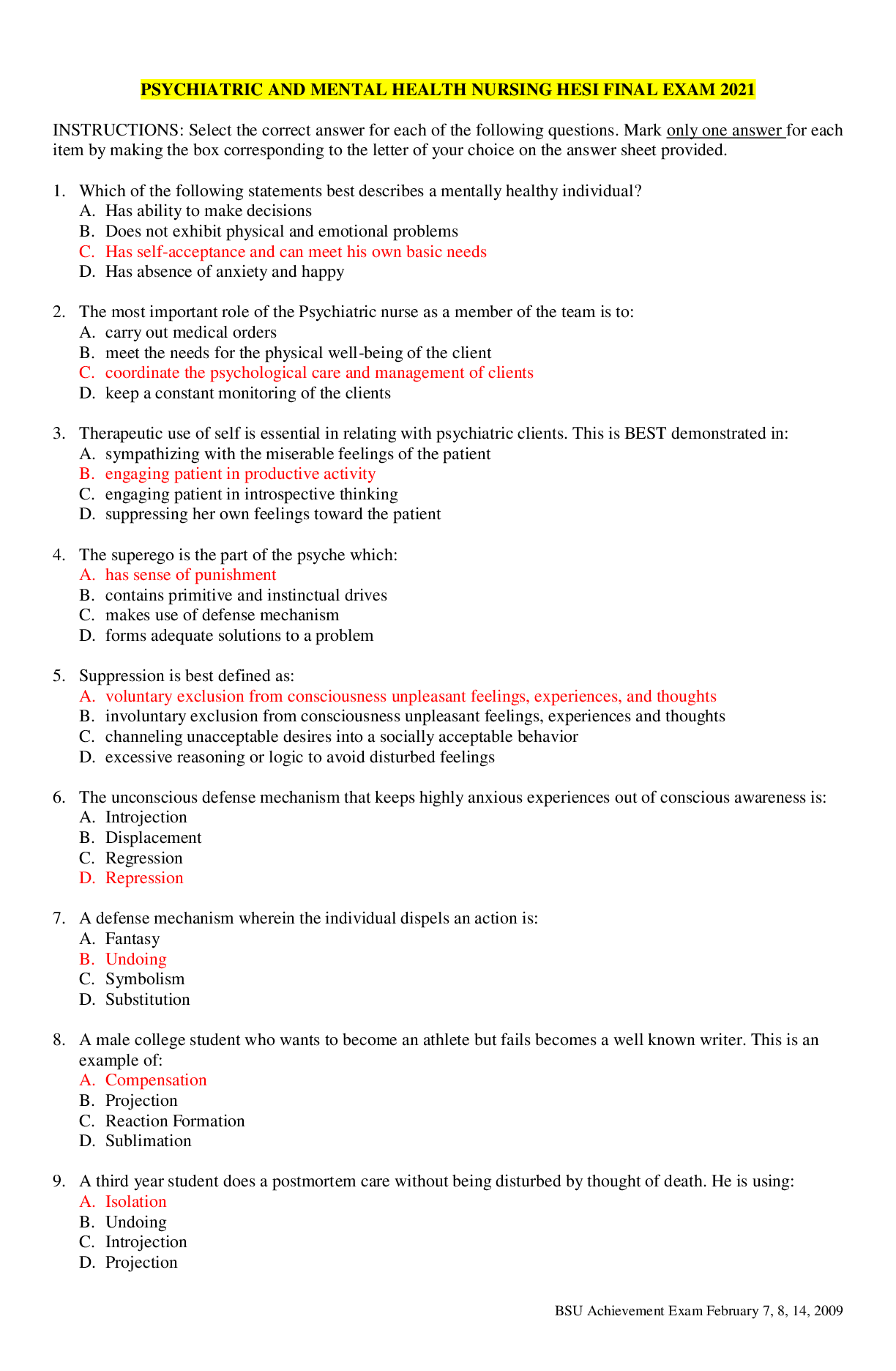
Reviews( 0 )
Document information
Connected school, study & course
About the document
Uploaded On
Apr 21, 2021
Number of pages
11
Written in
Additional information
This document has been written for:
Uploaded
Apr 21, 2021
Downloads
1
Views
216

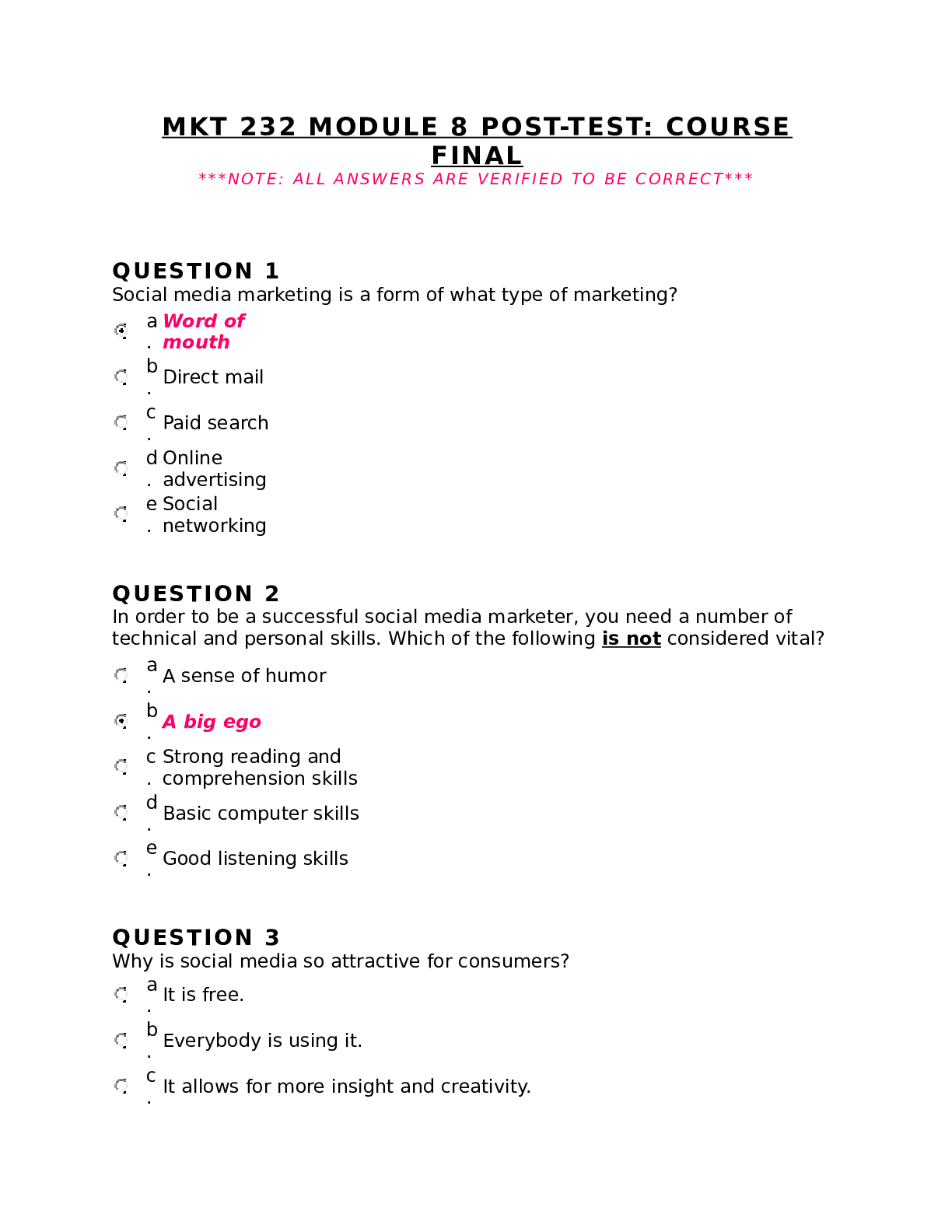
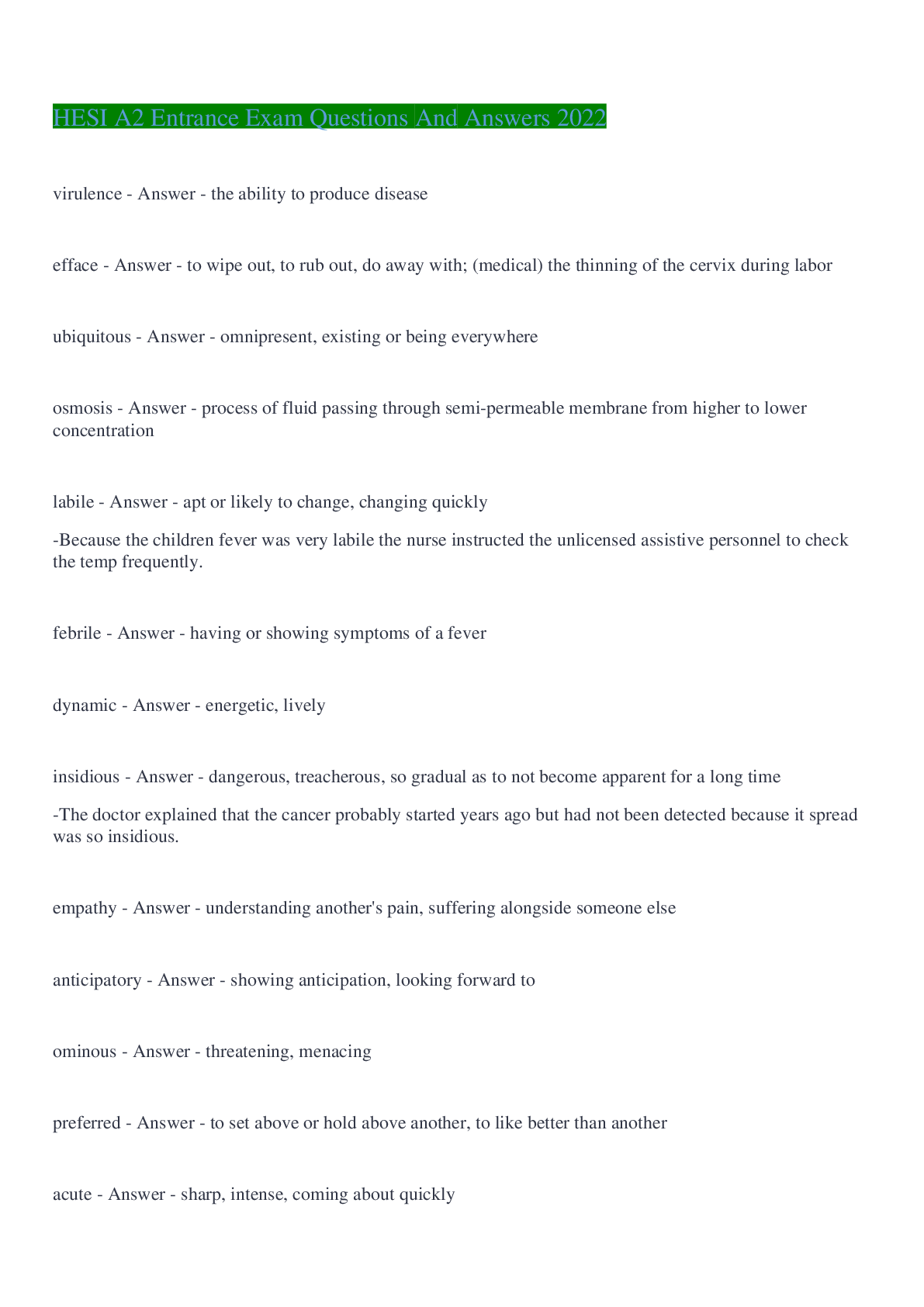
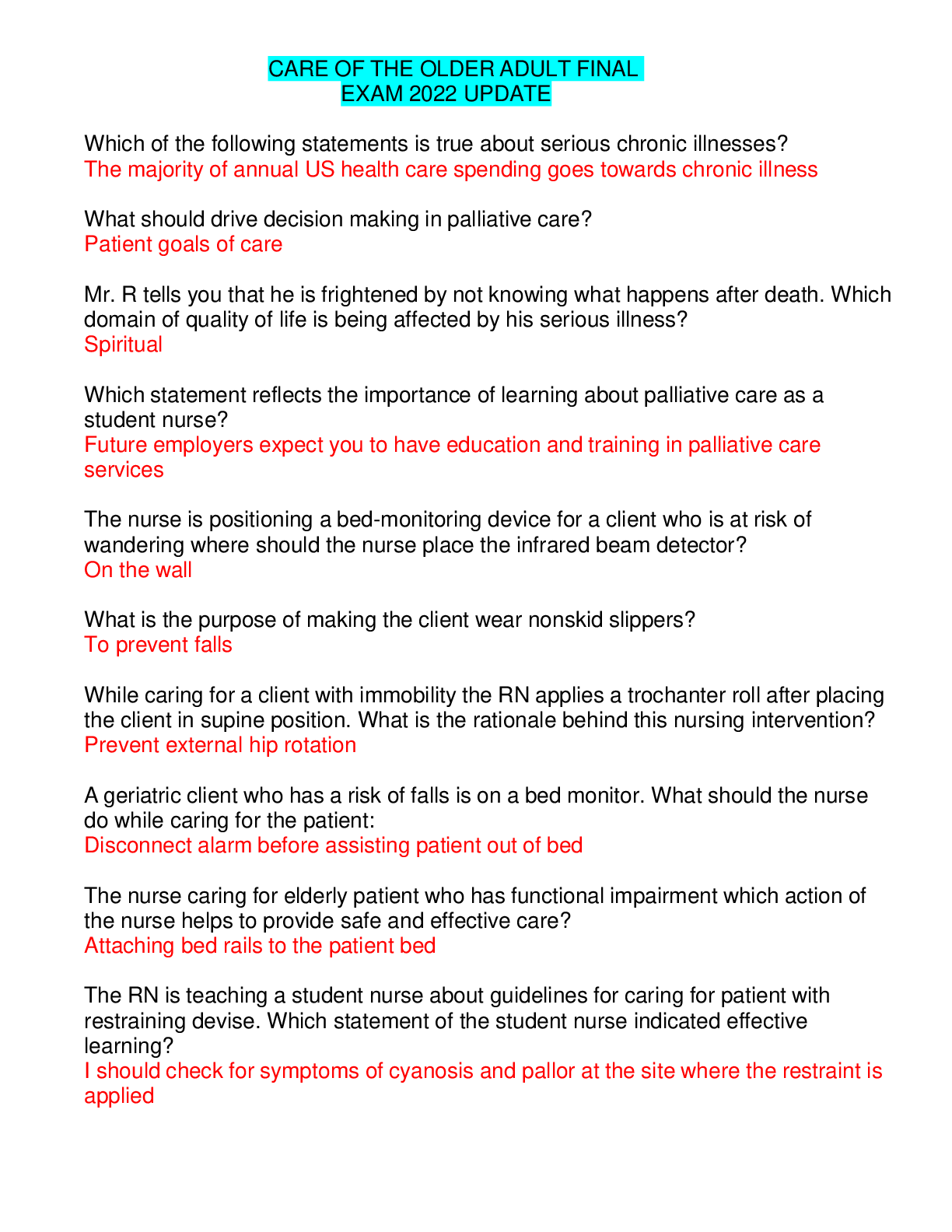
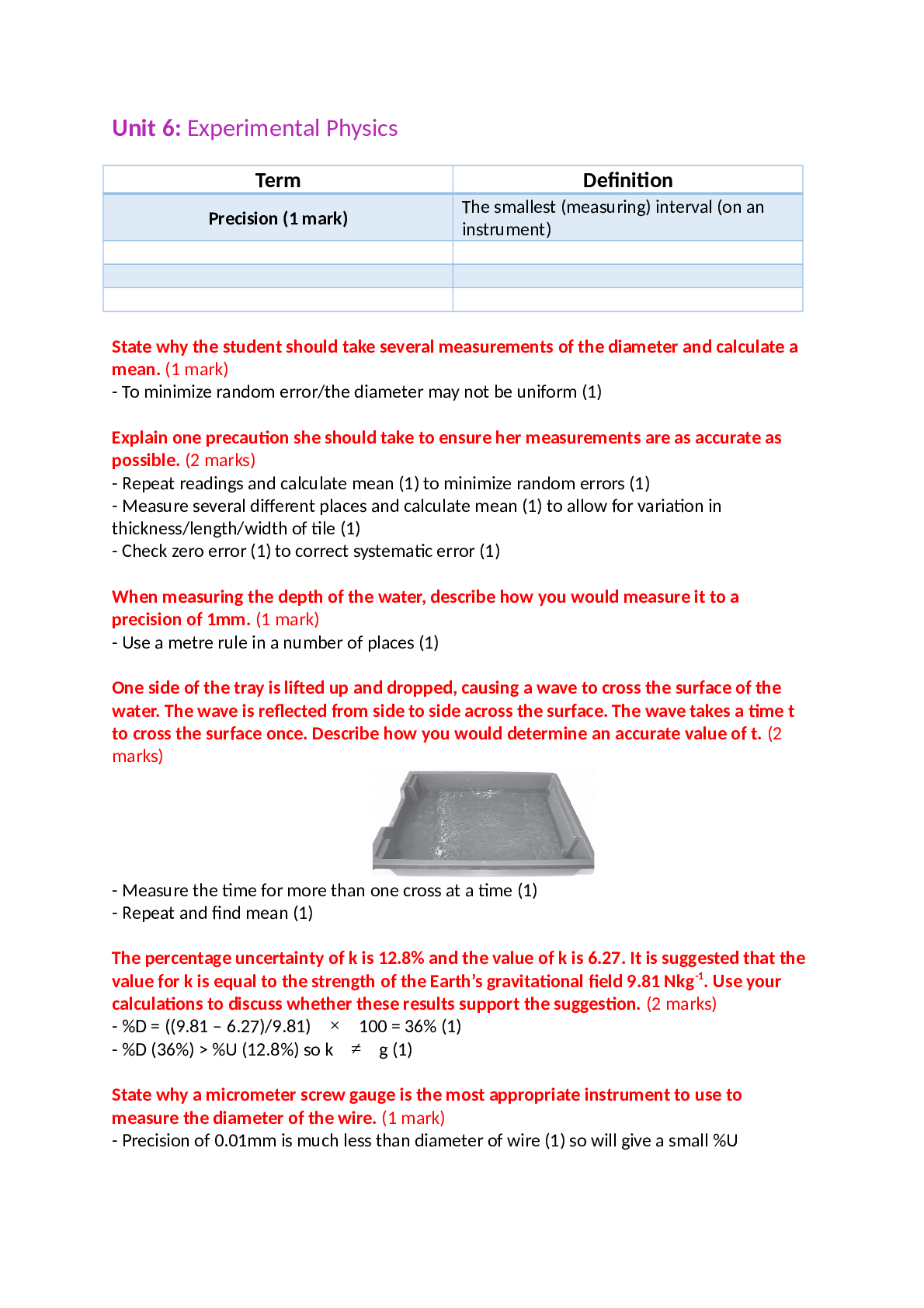


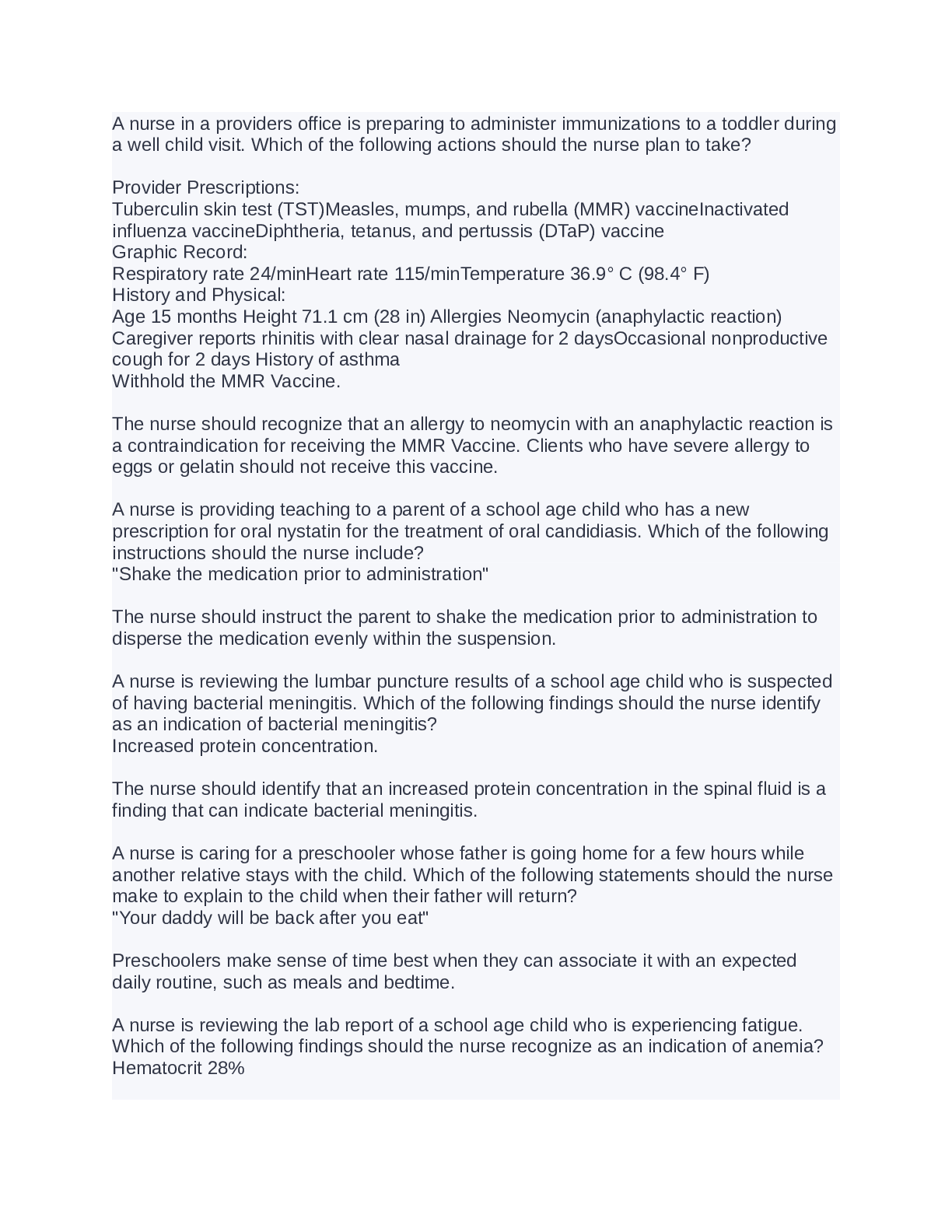
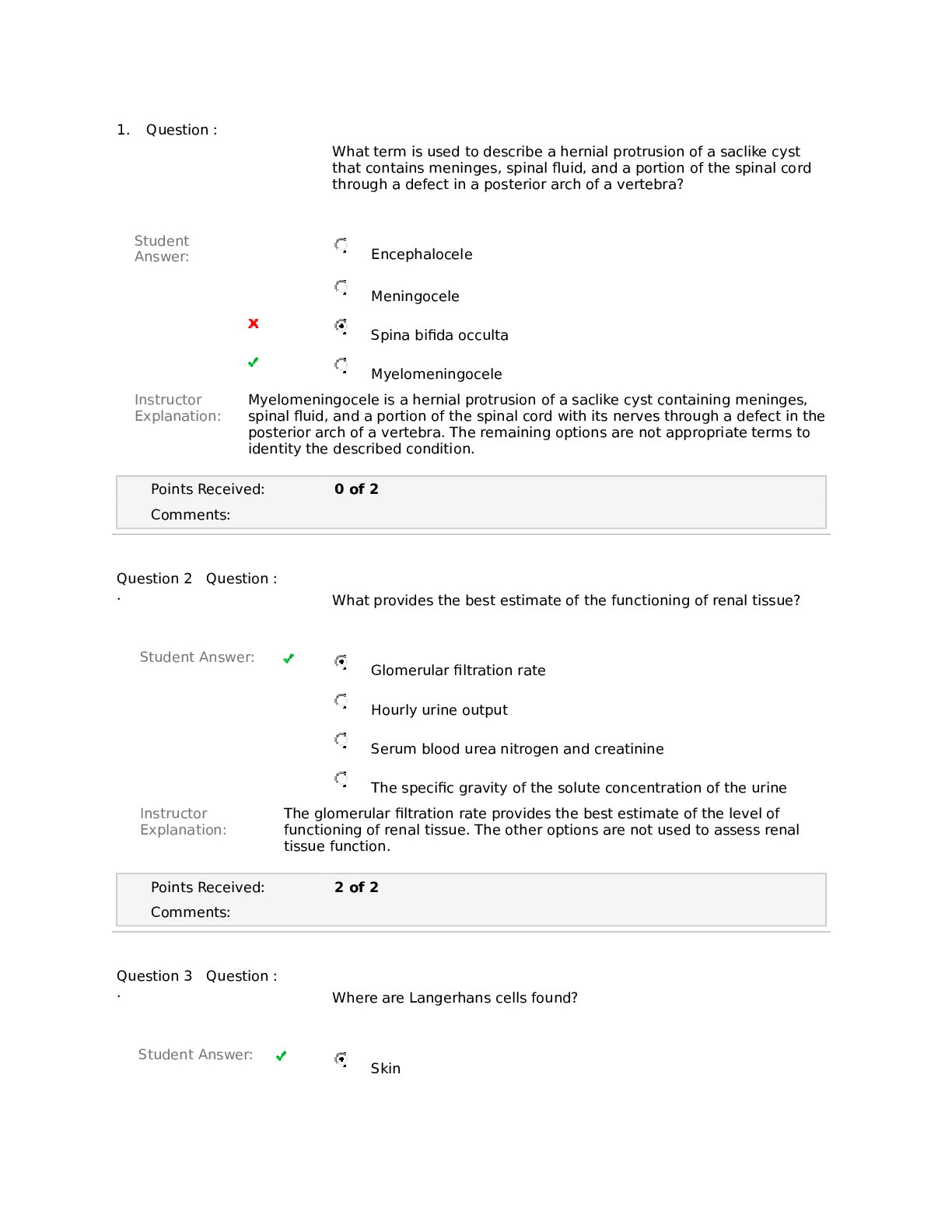

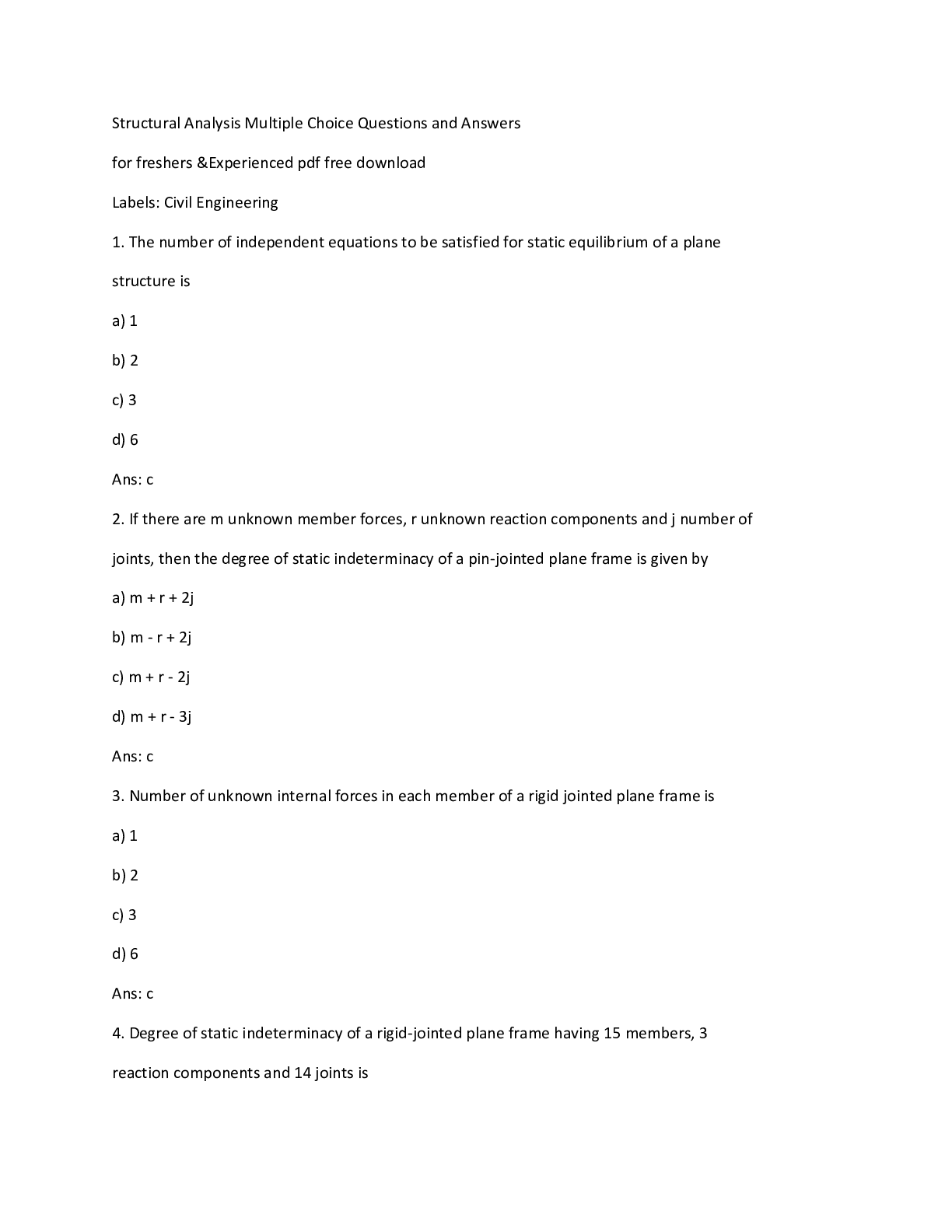


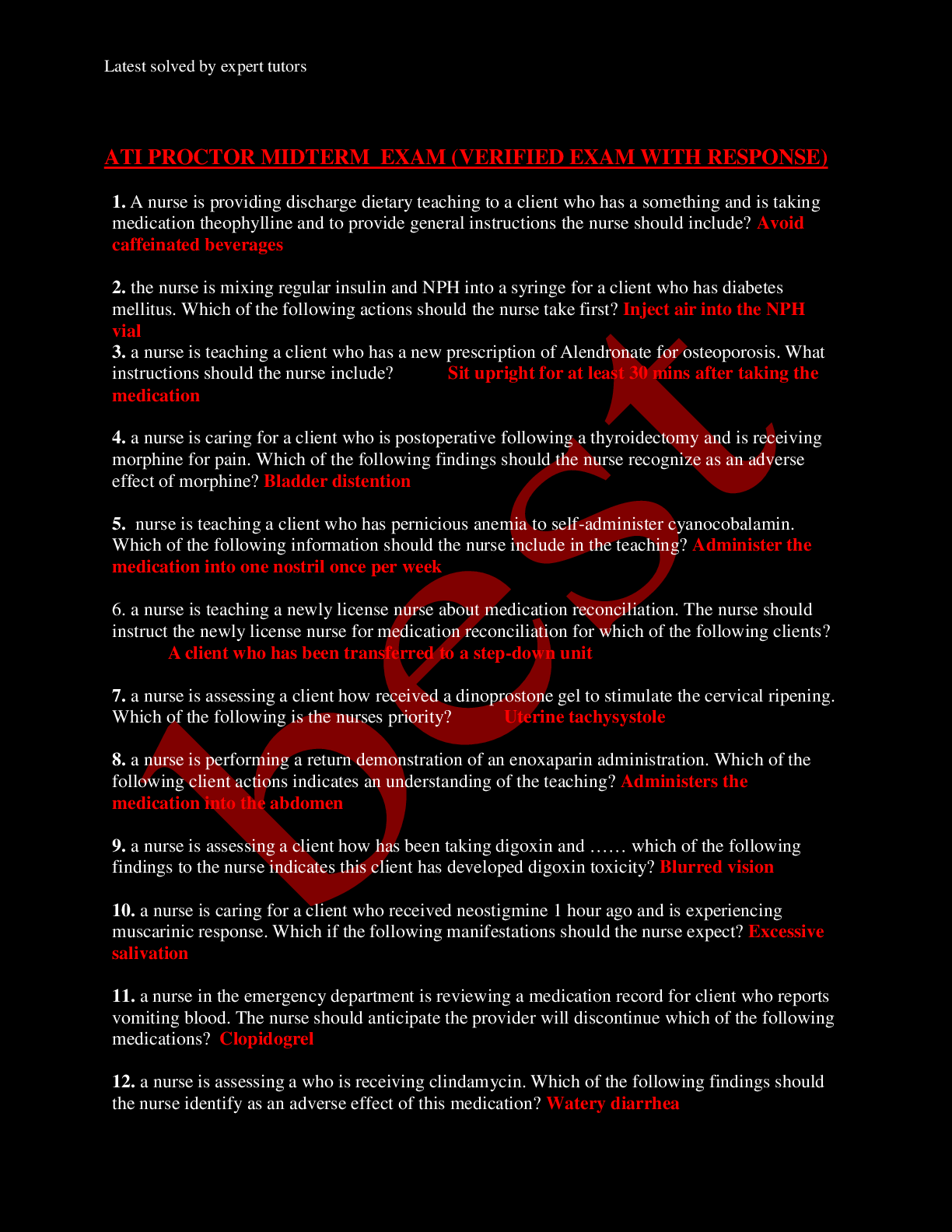

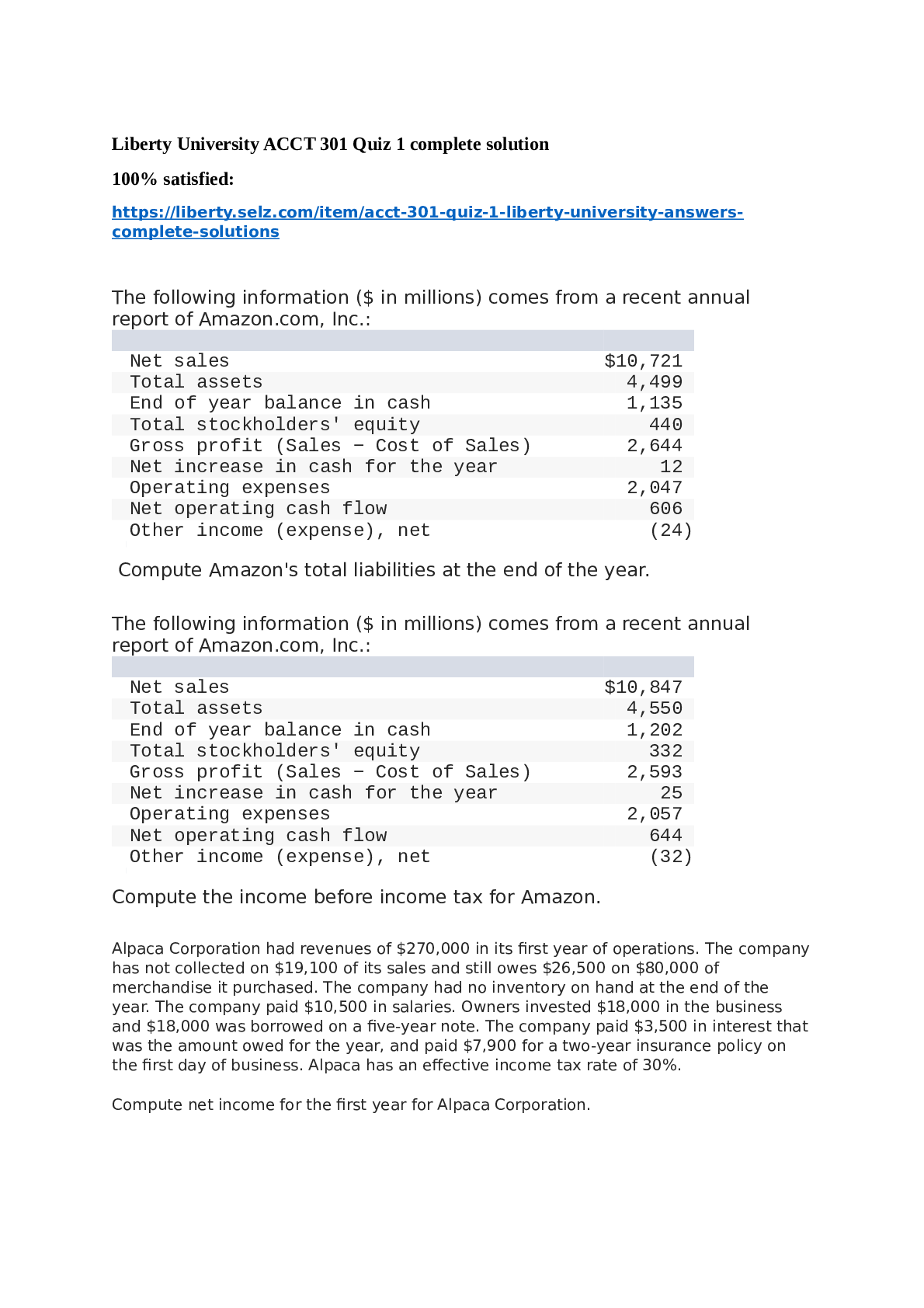
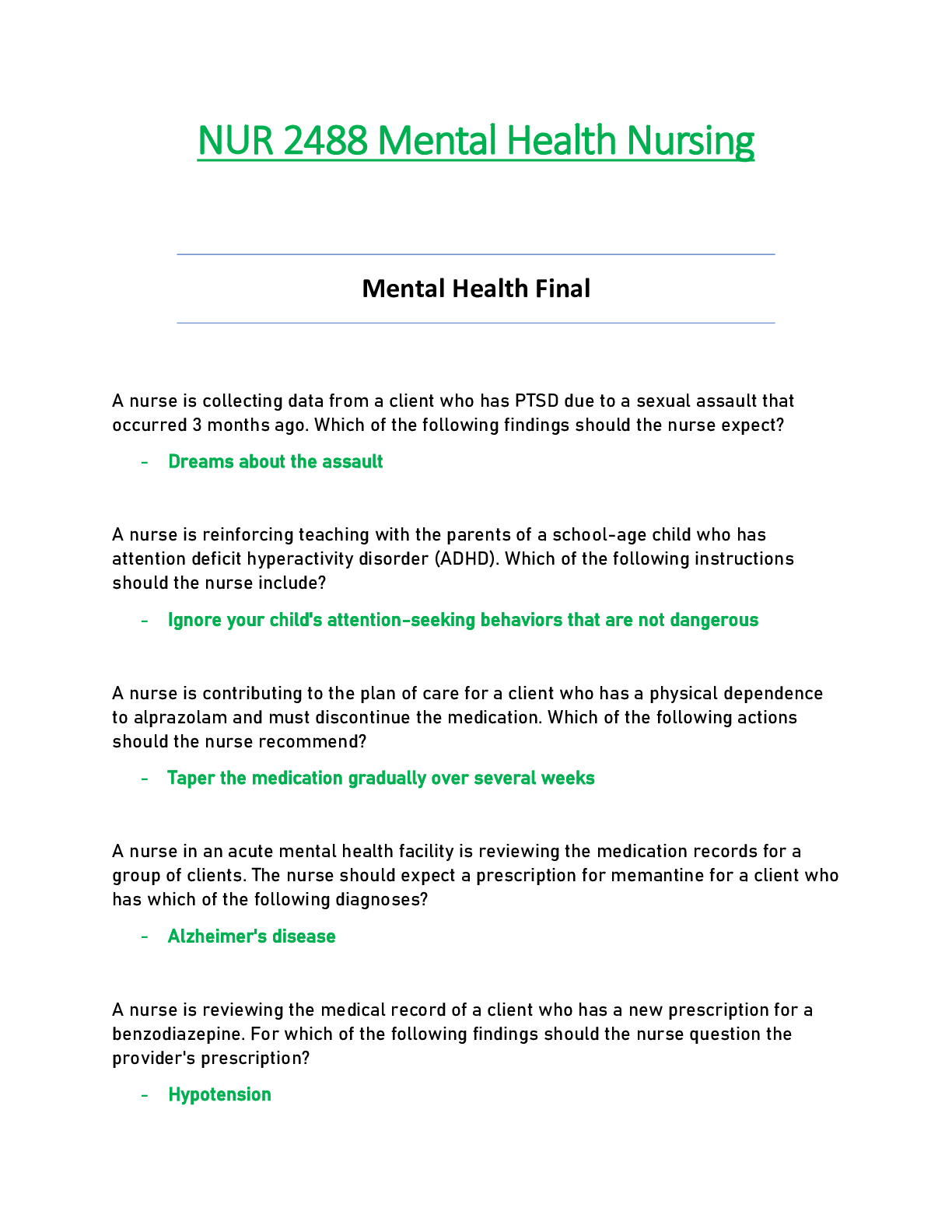
 AG21.png)


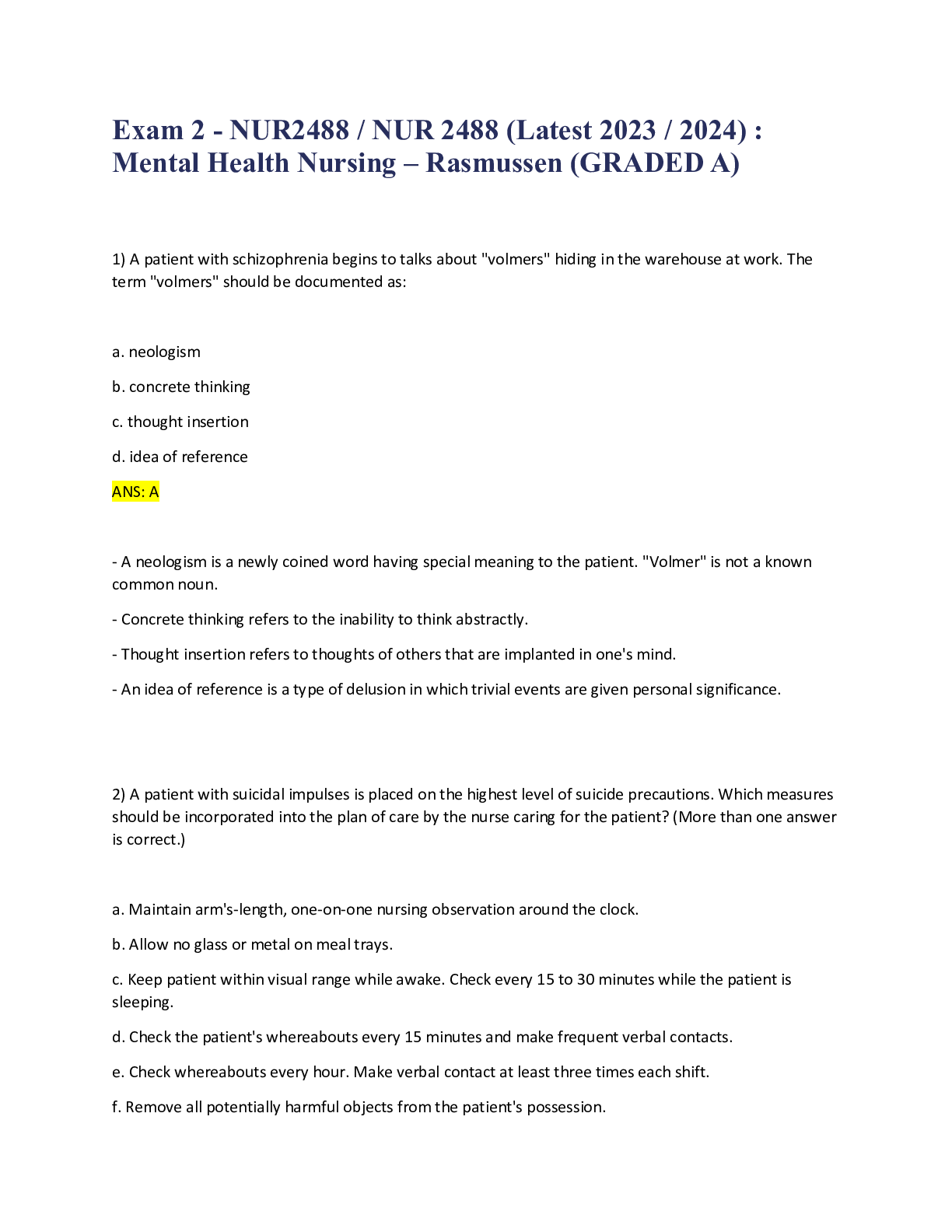
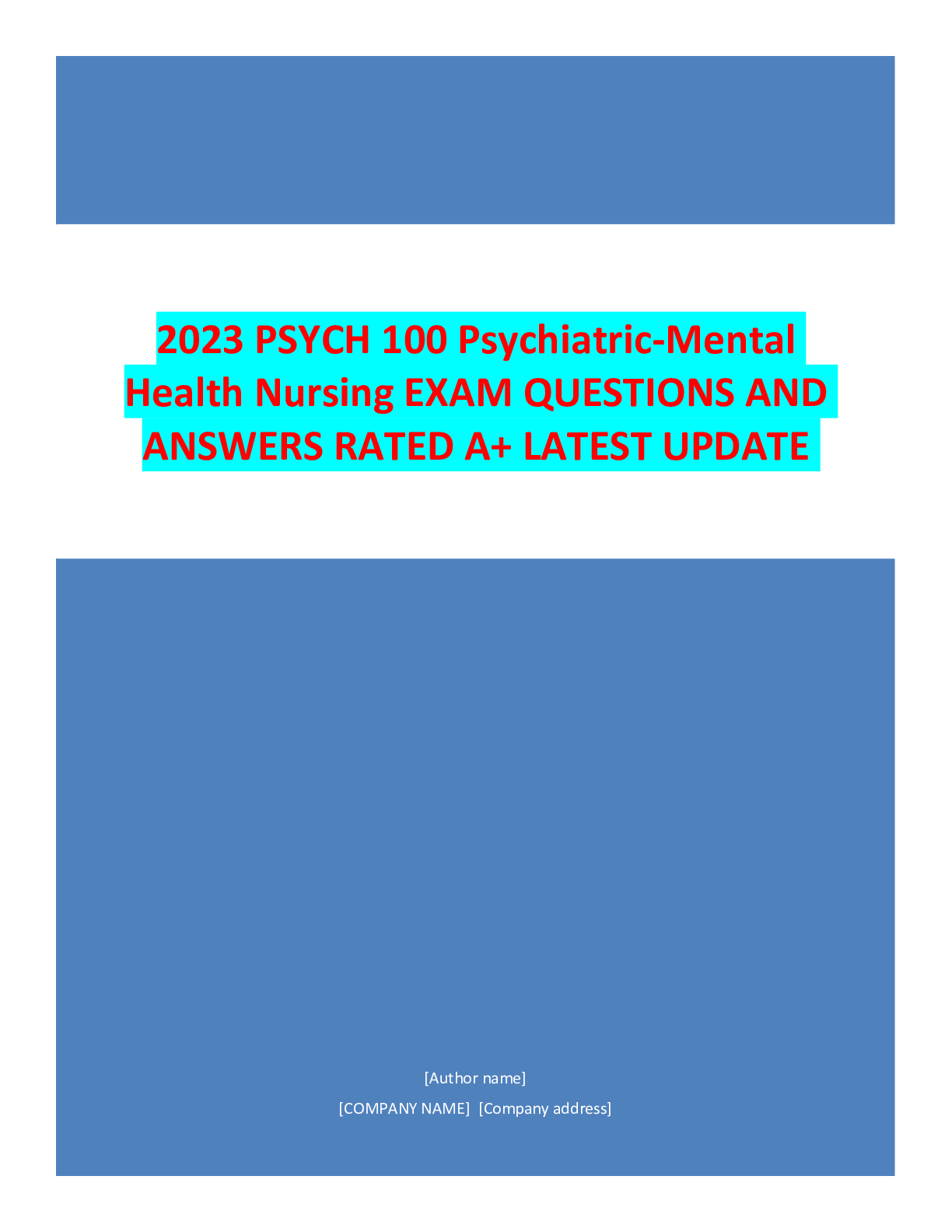
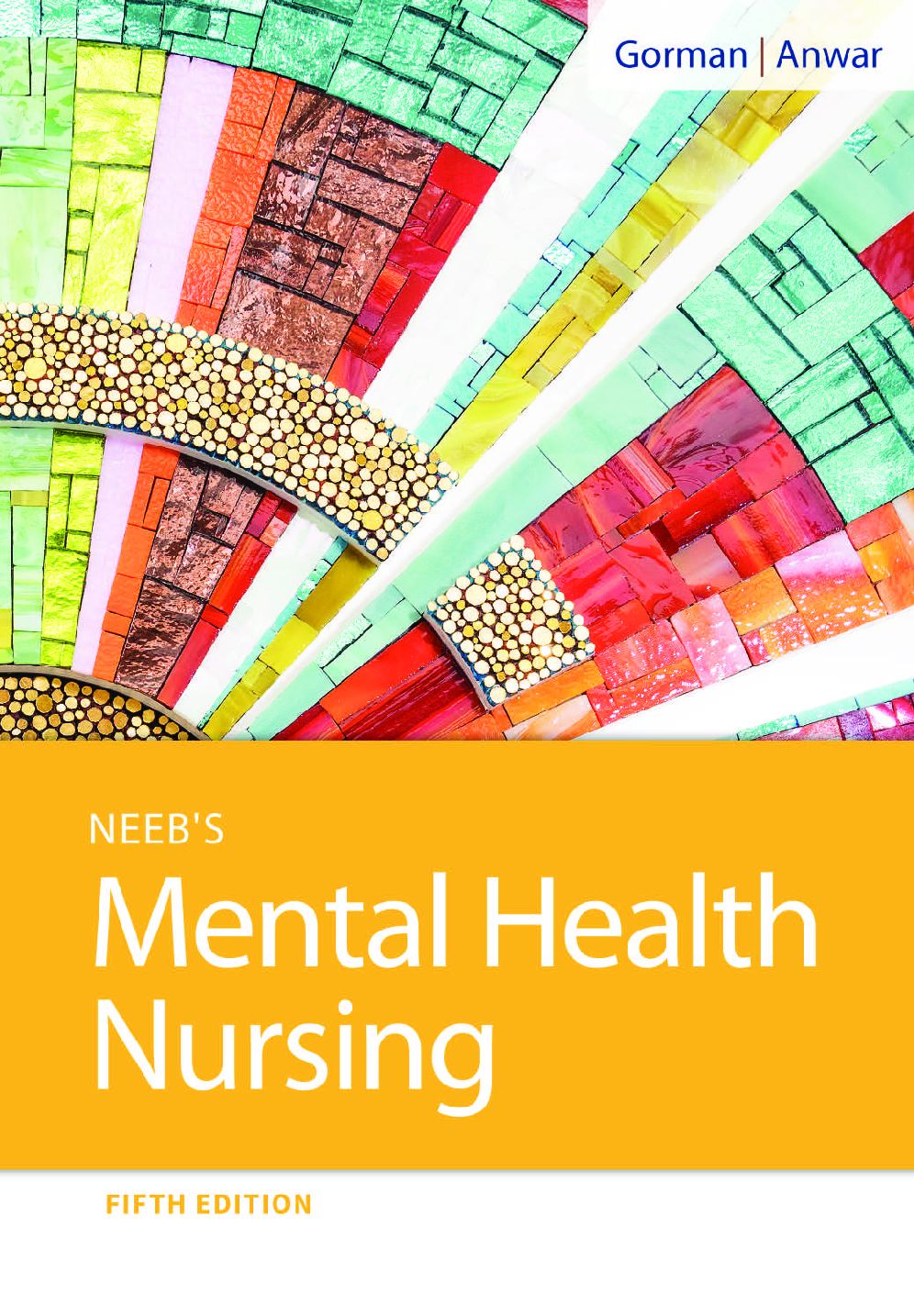


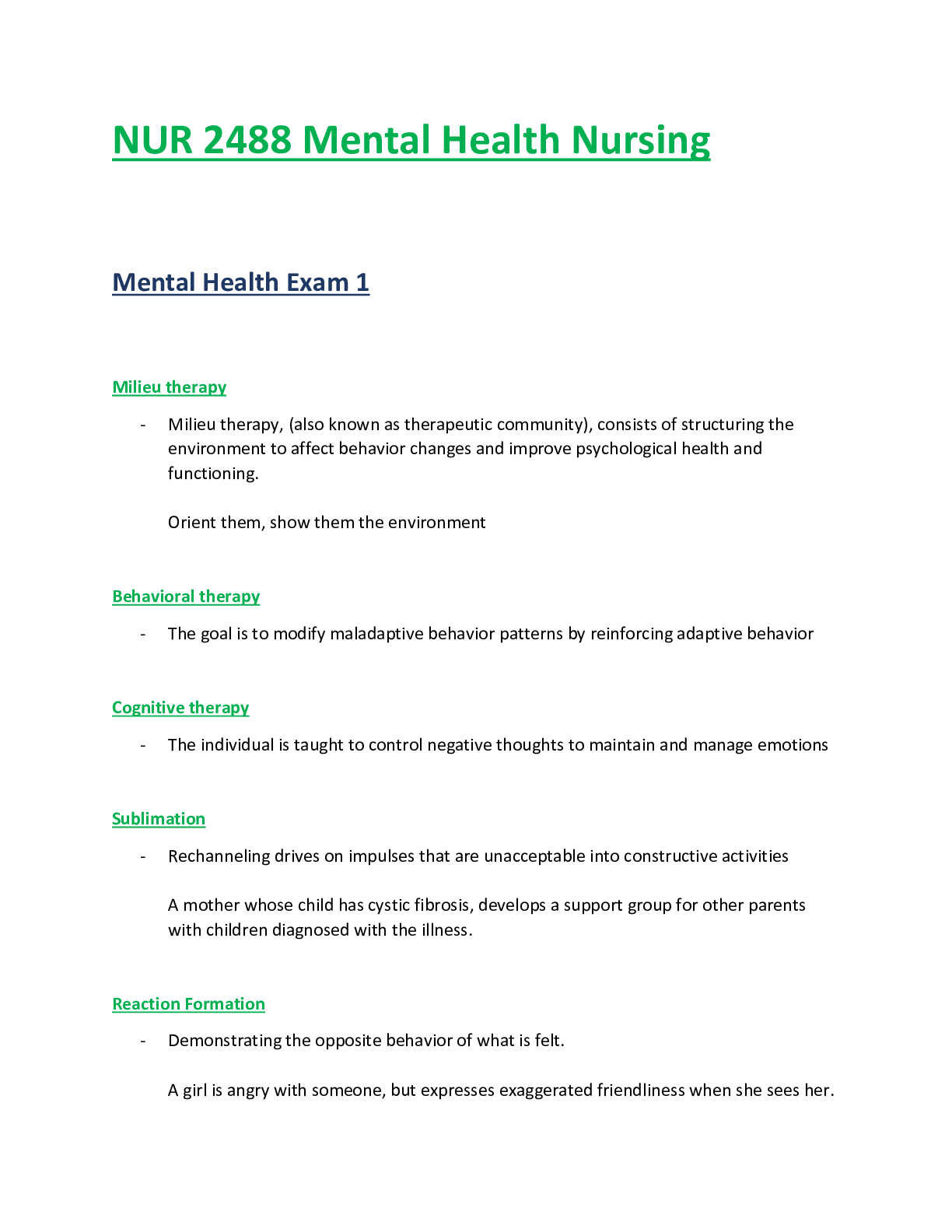
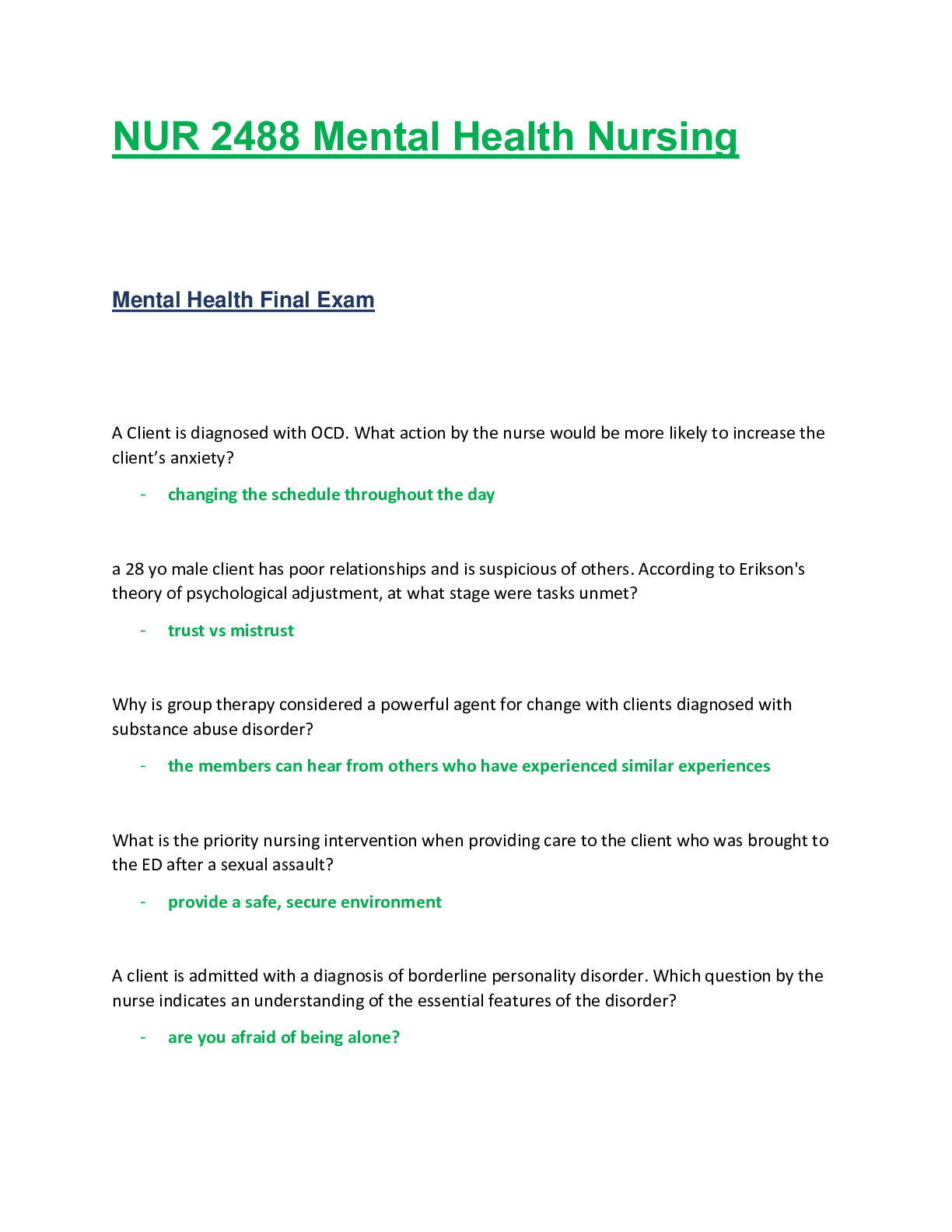
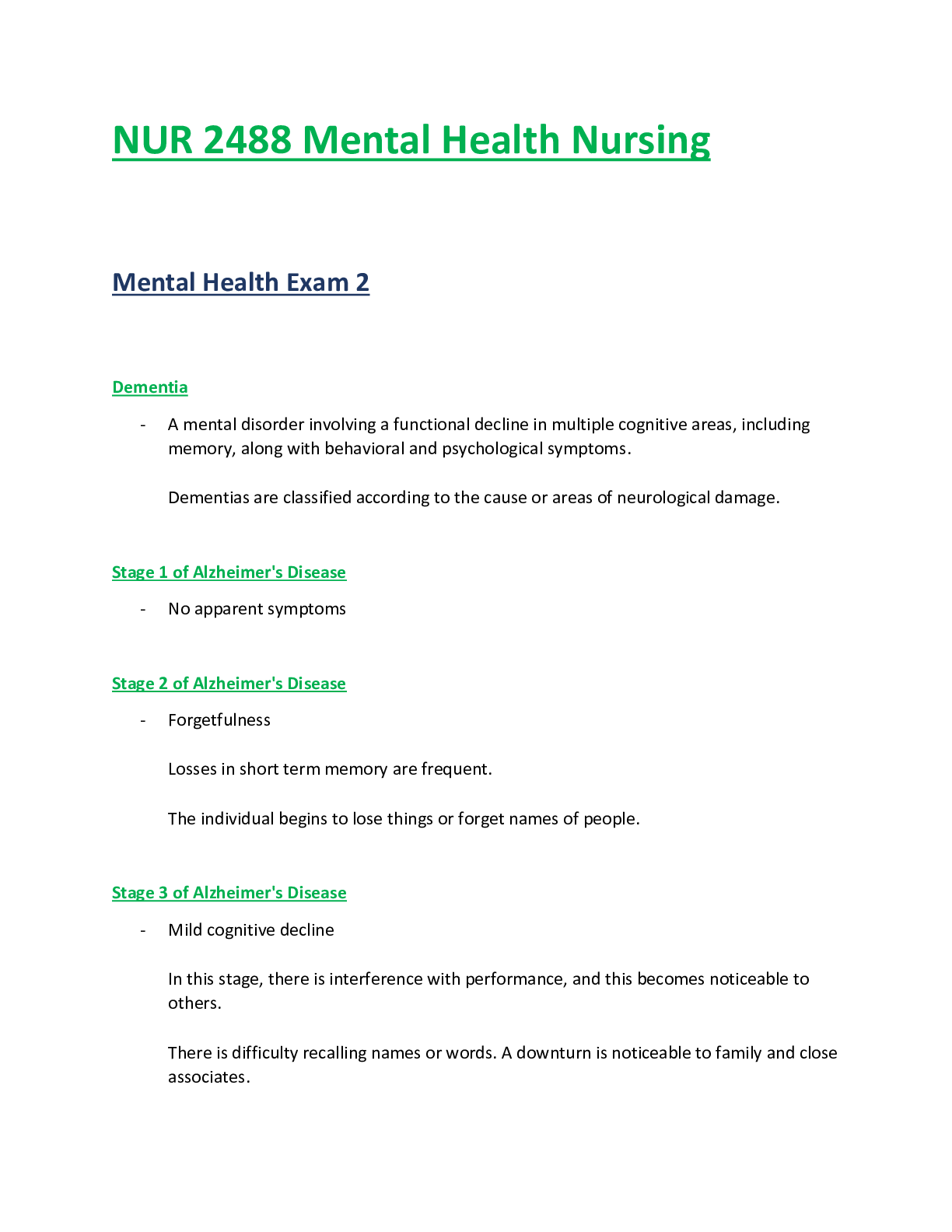
 F21.png)
